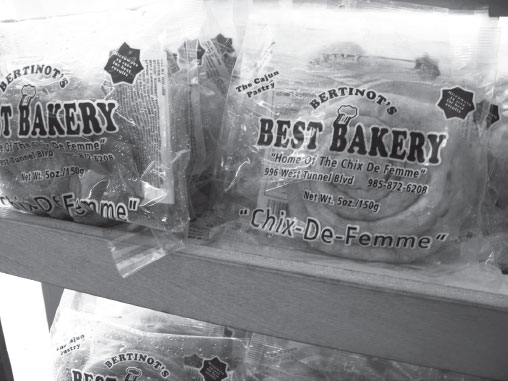
Chix-de-femme pastry, a cinnamon specialty prepared from a one-hundred-year-old recipe by Bertinot’s Best Bakery in Houma. Photo by author.
Sweet Breads
CHIX-DE-FEMME
Bertinot’s Best Bakery
996 West Tunnel Boulevard
Houma
The unique sweet roll from a one-hundred-year French recipe steals the show at Bertinot’s Best Bakery, established in 1943. The chix-de-femme, French for the “bun of a woman,” is a yellow spiraled pastry covered lightly with cinnamon sugar and a gooey glaze. Similar to a honey bun, the recipe for the plump roll resembling a woman’s chignon is believed to have journeyed from France to Cajun Country to Excelsior Bakery, a downtown shop in Houma opened in 1880.
From here, the sojourn of the tasty treat gets a little fuzzy, as the bakery changed hands and bakers moved around while also guarding the old recipe. It ended up at Bertinot’s Best Bakery in Houma, an old-fashioned shop that continues to bake fourteen dozen chix-de-femme daily, keeping the time-honored sweet before customers.
The bakers use this same classic dough to prepare their version of another Louisiana specialty, the king cake. The most requested king cake flavor is the chix-de-femme king cake, which includes pineapple bits. All flavors of king cake—including unique ones like Almond Joy and piña colada—are available year-round and may be decorated for any holiday or special occasion.

Chix-de-femme pastry, a cinnamon specialty prepared from a one-hundred-year-old recipe by Bertinot’s Best Bakery in Houma. Photo by author.
Pretty baked goods in a glass showcase greet customers to the cozy shop. On hand are cookies, banana and cranberry loaves, brownies, scones, mini pecan pies and bread pudding squares. The ginger cakes, with a taste similar to gingerbread, are hand rolled, and big cookie cutters are used to get a consistent oblong shape of six inches long. Another popular treat is the thin French puff pastry lightly dusted with sugar, nicknamed a “shoe sole” because of its shape.
Bertinot’s pastry crew comes in at 10:00 p.m. to work all night, and the bread crew reports for duty at 3:00 a.m., all with a checklist of special orders. One hundred loaves of crusty French bread are baked daily for local restaurants, as well as for patrons waiting in line for the first hot one out of the oven. By dawn, coffee is brewing, and the lovely scent of baking is drifting throughout the neighborhood.
Anthony Matrana drove a bread truck for many years, making deliveries and taking orders, followed by years kneading dough at Best Bakery before purchasing it for his family in 1995. His daughter Melissa Bertinot was a shoe-in for taking over the shop. During her senior year in high school, her interest in the culinary field shined through upon winning first place in a baking competition in which she baked a batch of oatmeal cookies and decorated a cake. Upon graduation, Melissa was offered a scholarship to attend culinary school, yet she opted instead to arm herself with a rolling pin to begin working in the family bakery. She took over ownership ten years ago, updating the name to Bertinot’s Best Bakery knowing that owning a bakeshop would mean challenges of early mornings and the tempting aroma of sweets baking all day long. But along with that came the reward of welcoming new customers overjoyed to grab a batch of yummy delights to take home.
BREAD PUDDING
Bread pudding is no wallflower dessert. Although it’s considered a simple dessert that is at ease being served in fine dining cafés or small coffee shops, this sweet dish evolved from a creative manner for thrifty Cajuns and Creoles to use stale bread. It is embraced as one of the most popular desserts in Louisiana. With a clever sleight of hand, the cook may prepare bread pudding as a true custard-like pudding or more cake-like, perhaps with a meringue or rum sauce to dress it up. It’s not an exotic dish, though variations are virtually endless, as the mainstay ingredients may include crusty French bread, sliced loaf bread, cinnamon raisin rolls and even doughnuts. For sweetening, honey or brown sugar, berries, fruit, chocolate, canned fruit cocktail or nuts can be added, along with a sprinkling of cinnamon and nutmeg. The layers of bread are converted to a blissful creation by thoroughly soaking them overnight in an egg and sugared milk mixture, perchance with a gentle lacing of brandy or vanilla flavoring. Once baked, the pudding is delicious served either warm or cold.
Bread pudding has been traced to late medieval times as a way to use leftover bread from feasts rather than throw it out, although it could have been prepared either sweet with rosewater rather than milk as an ingredient, or savory, stuffed with meat.
As a show of southern hospitality, a feast for guests was prepared after gentlemen spent a day out hunting and the ladies played parlor games.
Bread pudding is a delicious way to use leftover bread. Courtesy of the Lake Charles Convention & Visitors Bureau.
A typical antebellum evening spread included beefsteak pie, pork sausage, pickled oysters and fried chicken, along with homegrown side dishes of carrots, okra and stewed pumpkin and accompanied with sweet potato buns. Sips of molasses beer were offered to the gentlemen and raspberry cordials to the ladies. A popular dessert was sippet pudding, a forerunner to our bread pudding (sippet means a small piece of bread), as popularized in what is considered America’s first regional cookbook. Homemaker Mary Randolph, a cousin of President Thomas Jefferson, published Virginia House-Wife in 1824, including numerous recipes of the day, as well as insight into the antebellum social culture. Her sippet pudding recipe included setting up a layer of bread slices that were enhanced with currants or raisins and dabs of butter. A mix of eggs, milk, sugar and nutmeg was poured over the layers, followed by baking. Her version advised enjoying the pudding with wine sauce.
Today’s bread pudding was also known as “poor man’s pudding,” considered a simple dessert the lower class could enjoy. During the American Civil War, soldiers looking for something sweet used crushed crackers if they did not have bread and added a touch of sugar or honey along with some hot water or milk to fashion something similar to bread pudding.
Pujo Street Café
901 Ryan Street
Lake Charles
The quaint café in a classic red-brick building in downtown Lake Charles has an upbeat vibe. Diners may enjoy a nice stroll from the eatery to nearby art galleries as well as to the summer evening concert series “Downtown at Sundown.” The building that houses the café was originally Gordon’s Drug Store, built in 1886, which included a downstairs pharmacy and an upstairs doctor’s office. At the time the building was constructed, Lake Charles enjoyed a growth spurt sparked largely by a regional expansion of the timber industry. As prosperity increased in the flourishing town, carriages replaced ox carts, residents flocked to Fricke’s New Opera House and maskers attended fanciful Mardi Gras celebrations. A few years later, in a remodeling effort that likely gave Gordon’s a second life, brick was added to the drugstore’s wooden structure, which saved it from destruction during the Great Fire of 1910. The fire spread throughout the downtown area, destroying most of Lake Charles and leaving five thousand people homeless.
In 1993, Pujo Street Café opened in a terra cotta–colored house, later expanding and moving to its current location in the Gordon building. Petfriendly courtyard dining and a rustic interior of brick, along with a woodsy bar for gathering, gives the restaurant a relaxed setting. The menu includes a nice variety of hamburgers, steak, sandwiches and seafood. Sunday brunch draws in lots of folks and so does the dreamy signature dessert of bread pudding, a custard baked to a golden brown and topped with rum sauce.
A-Bear’s Café
809 Bayou Black Drive
Houma
Grab a rocking chair on the front porch to settle in at a restaurant reminiscent of grandma’s kitchen. “Hebert” is a Cajun-French surname popular in these parts, though you may not be guess that the name is actually pronounced “A-Bear,” and that’s where the name of this family-owned restaurant originated.
Curly and Jane Hebert set up shop in 1963 with the motto “Thank you for coming to our house.” While Albert “Curly” Hebert did most of the “pot cooking” like gumbo and red beans and rice from his home kitchen, he had already earned a reputation as a top hotplate lunch cook in southwest Louisiana. Jane tackled the famed homemade desserts of which she prepares six or seven daily. Most of her recipes came from her mother, Lottie Breaux, born Charlotte McGowan, who came to Louisiana from New York City in 1907 on the Orphan Train.
Originally built as a house with 1920 cypress wood, the café enjoys a country-chic atmosphere. The decoration of floral tablecloths adds to the homespun atmosphere, especially with a setup of home-canned fig preserves for sale at checkout. You’ll learn a lot if you strike up a conversation with the A-Bear team, all jacks of all trades, as they rush through spending time in the kitchen preparing desserts, greeting and visiting with customers or clearing dining tables.
On the menu is local Cajun fare like gumbo, po’ boys, jambalaya, fried seafood and hefty lunchtime plate lunches (well known for fried catfish). The sweet course is not something you should skip. A-Bear’s is best known for its luscious bread pudding, a cake-like wonder covered in warmed-up creamy sauce. Other desserts include peanut butter pie in a crunchy pie crust crowned with whipped topping, seasonal blackberry or peach cobbler, chocolate cream pie and lemon meringue pie. It’s worthwhile taking an extra helping of dessert home in a to-go box for late-night snacking.

Homemade desserts paired with Cajun music at A-Bear’s Café in Houma. Photo by author.
Every Friday night stands for amusing entertainment by taking in the whole experience of people-watching and listening to toe-tapping music. Lots of family and friends ramble in to sit at their usual spots. Things get hopping when the three-man band plays old Cajun-French standards like “Jolie Blonde” but with an unexpected German oompah beat from the accordion player. A catchy rendition of Hank Williams’s hit “Jambalaya” includes a saxophone playing in the background. Snappy music gets dancers out to two-step as they circle around the tables. The versatile repertoire includes some Fats Domino and a Beatles tune customers can sing along with. With a cold beer in hand, foodies will enjoy the weekly fais-do-do (Cajun dance).
Note: Curly Hebert died in January 2017, but the legacy of his homegrown dishes lives on.
The Grapevine Café
211 Railroad Avenue
Donaldsonville
A walk through Donaldsonville’s streets takes you to shotgun houses, historic churches, museums and other architectural buildings reminiscent of New Orleans. One former speak-easy called the Tavern, reportedly frequented by Al Capone during bootlegging years, now houses Grapevine Café and Gallery. The two-story building, which dates to 1925, has had an appealing charm in downtown Donaldsonville since opening its doors as a restaurant in 2001. Since major renovation was done to preserve the eatery to National Historic Preservation guidelines, it serves as a proper destination for history buffs.
A blast of color comes from local art displayed on interior brick walls overlooking original hand-crafted mosaic tiles. Live music is played on weekends in the outdoor courtyard. The setting is reminiscent of the time when a Tin Lizzie from the Roaring Twenties would drive up. The locale has been the scene of many movies, including All the King’s Men (2006), with Sean Penn, Kate Winslet and Anthony Hopkins.
Chocolate adds some dazzle to any dish, so customers are invited to linger for the specialty of the Grapevine’s luscious, award-winning white chocolate bread pudding, which is rich and creamy, doused in a white chocolate sauce. Cajun and Creole dishes are featured, including turtle soup, pecan-crusted shrimp and a multilayer specialty called Eggs-Plant Marcello, fried eggplant wheels topped with crawfish étouffée or crabmeat au gratin and poached or scrambled eggs.
Mulate’s Restaurant
201 Julia Street
New Orleans
As the “Original Cajun Restaurant,” Mulate’s has the fun-loving mood of Mardi Gras and other entertaining aspects of New Orleans. Lively Cajun music with the fiddle and accordion, often called “chank-a-chank,” is featured daily. Spontaneous entertainment is enjoyed as animated dancers twirl around the dance floor. Mulate’s started as a humble eatery in the small town of Breaux Bridge, Crawfish Capital of the World, in 1980. Ten years later, Mulate’s opened another location in a prime spot in New Orleans—the revitalized warehouse district. Directly across from the Ernest Morial Convention Center and the Riverwalk, the nineteenth-century building that houses Mulate’s has gone through many lives as a hotel, a stable for the Faubacher Brewery, a cotton warehouse and an icehouse. Patrons recognize it as the place to go for seafood—like gumbo, crawfish, po’ boys, fried alligator and frog legs for appetizers. The one-of-a-kind zydeco salad is topped with blackened catfish, grilled shrimp, fried crawfish and smoked sausage medallions. Desserts include the homemade bread pudding topped with a butter rum sauce in a recipe that includes hamburger buns. There’s also key lime pie and a refreshing spiced root beer float with ice cream and spiced rum.
Mulate’s Homemade Bread Pudding
Courtesy of Mulate’s Restaurant, New Orleans, Louisiana
6 eggs
1 teaspoon vanilla
2 cups whole milk
2 cups half-and-half
1 cup sugar
6 hamburger buns
½ cup raisins
Preheat oven to 350 degrees. In a large bowl, whip eggs, and then add vanilla, milk, and half-and-half. Mix well. Add sugar and mix well. Grease a 9 x 13 pan. Break hamburger buns into pieces and place in greased pan. Sprinkle raisins evenly throughout the bun pieces. Pour egg mixture over buns. Using your fingers, make sure that all bun pieces are soaked with the mixture. Bake for approximately 45 minutes. If you prefer a firmer texture, chill for about 2 hours, then reheat for serving.
Butter Rum Sauce
½ stick butter
¼ cup sugar
½ cup half-and-half (or heavy cream)
½ cup rum
Melt butter. Add sugar and cook on medium heat for 3 minutes. Add half-and-half and rum and cook for 5 more minutes or until slightly thickened. Serve warm over bread pudding. Serves 8 to 10.
FRENCH TOAST
Pain Perdu / Lost Bread
The crispy fried breads we know as French toast are a simple dish with a regal history. During the days of the Roman Empire, it was called pan dulcis, and Romans soaked bread slices in a milk and egg mixture before frying them in oil or butter. In Britain, one version was called “Poor Knights of Windsor,” though the boozy bread was dipped in a beaten egg yolk followed by a soaking in a sugar and sherry mixture before frying. The Poor Knights of Windsor was a military order formed by King Edward III in the fourteenth century. French toast was also known in Britain as gilden sippets, which were bread slices sprinkled with rosewater. It is known as rascal’s slice in Switzerland and bread-in-a-coat in the Czech Republic.
In Louisiana, we know it more as a custardy affair. As Creoles never wasted anything, the sweet dish became a good way to rescue bread, especially crusty New Orleans French bread that can become stale overnight. As a breakfast treat or a nice dessert, the bread slices are soaked in an egg, sugar and milk mixture with a dab of vanilla flavoring, sometimes with a little cinnamon or nutmeg thrown in. Then the slices are lightly pan fried in butter until golden brown on both sides. Dressing it up with berries or cut-up fruit, spooning on top a dollop of jam, drizzling with Louisiana sugar cane syrup or sprinkling with powdered sugar adds to the flavor.
Elizabeth’s Restaurant
601 Gallier Street
New Orleans
It takes some imagination to combine the two well-known Louisiana standards of pain perdu and flaming Bananas Foster to make one killer breakfast treat: overstuffed Bananas Foster French Toast. But Chef Byron Peck’s dressed-up version magically ties in the flamboyance of bananas but without the flame. Puffy slices of French bread are lightly grilled and stuffed with delicious Bananas Foster cream cheese.
A hipster joint, Elizabeth’s Restaurant is located in a one-hundred-year-old building that was formerly a corner grocery store. Located in the artsy ByWater neighborhood of New Orleans among a bohemian gathering of Creole cottages and shotgun houses, the eatery is a shining star.
Crowds have flocked to this funky restaurant for its popular weekend brunch since 1996, singing high praise for the eclectic menu. It’s a bustling, two-storied place with a ramshackle charm, decorated with colorful artwork and bright tablecloths. Appropriately, piggy décor abounds, as Elizabeth’s features praline bacon, a startling combo of pecan candy and salty pork the restaurant introduced twenty years ago. Aside from the overstuffed Bananas Foster French Toast, other dreamy desserts are on the menu, like the lemon chess pie and red velvet cake.
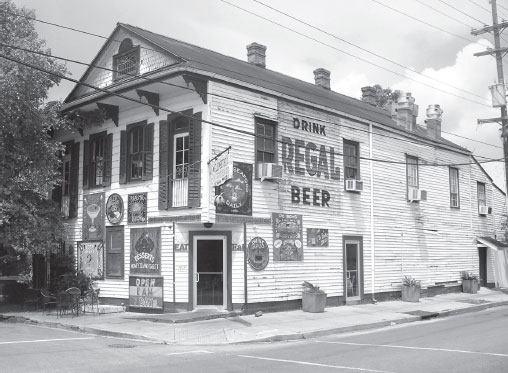
Elizabeth’s, a funky eatery in the ByWater neighborhood of New Orleans. Photo by author.
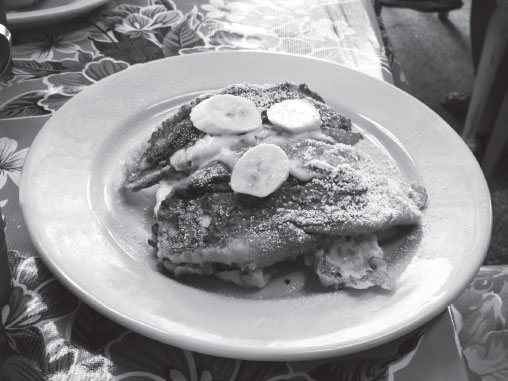
Whatever you may call it—pain perdu, lost bread or French toast—it’s a tasty dessert or breakfast treat. Courtesy of Elizabeth’s Restaurant.
Another brunch/dessert special is New Orleans calas cakes, a fried rice ball similar to beignets, topped with powdered sugar and dipped in Louisiana cane syrup.
“Real Food, Done Real Good” is what Elizabeth’s offers for breakfast, weekend brunch, lunch and dinner. It’s a fun place to hang out while sampling unique dishes, and there’s also a bar upstairs.
Old Castillo Hotel
220 Evangeline Boulevard
St. Martinville
Perhaps it was kismet when Louisiana native Peggy Hulin considered buying the Old Castillo Hotel, which began life in 1829 as steamboat captain Edmond Castillo’s luxurious inn for steamboat travelers along the Bayou Teche in St. Martinville. During the nineteenth century, St. Martinville was nicknamed “Le Petit Paris,” Louisiana’s third-oldest city. It was a fashionable resort that attracted New Orleans residents seeking a romantic getaway. The city is blessed with a rich and romantic history tied to a story of lost lovers through poet Henry Wadsworth Longfellow’s 1847 story of Acadian lovers Evangeline and Gabriel. Separated during the Acadian exile from Canada, Evangeline died of a broken heart beneath the moss-laden branches of the Evangeline Oak, which now provides shading for the Old Castillo Hotel.
When steamboat travel gave way to railroads, the hotel was sold to the Sisters of Mercy, who operated it as a convent and boarding school for girls for over one hundred years. Current innkeeper Peggy Hulin had no experience in running a restaurant or a bed-and-breakfast. While researching the history of the Castillo Hotel site, one of her cousins relayed that one of their direct ancestors, Don Louis Broussard, had once actually owned the property. Peggy took this as a sure sign to move forward with her plans of purchasing the building in 1987. She ran it first as a restaurant and now as a three-storied bed-and-breakfast with seven guest rooms.
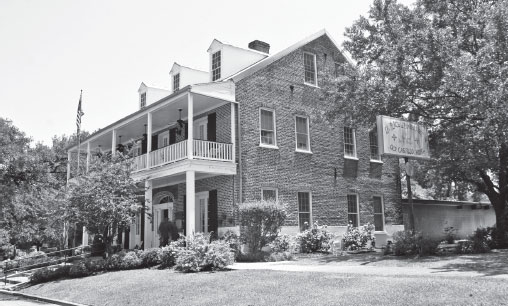
Romantic setting of the Old Castillo Hotel in St. Martinville. Photo by author.
French toast is served as part of the Cajun breakfast for her guests. An old family recipe uses stale sliced bread (she bakes her own bread) soaked in a mix of sugar, eggs and vanilla. She calls it lost bread, or in French, pain perdu, and explains to visitors, many who are new to Louisiana, why it’s called this as an introduction to the Cajun culture. People routinely baked their own bread before the days they could buy it wrapped on the store shelf. After a few days, the bread became stale and would be lost, or wasted, so making lost bread was a good way to prepare something special.
Bistro Byronz
8200 Village Plaza Court
Baton Rouge
Ooh la la! With an appealing décor, mostly in rich wood and black-and-white accents, this southern version of a quaint neighborhood French café has a full menu for brunch, lunch and dinner. Aside from soups and salads, there’s an outlandish sandwich called “gumbo po’ boy” of chicken and sausage gumbo served on po’ boy bread. Food Network’s show Burgers, Brew & Que praised the Bistro for its croque madame hamburger, which features a slab of griddled ham and a poached egg stacked on a ground turkey patty that is drenched in a bacony Mornay sauce. Originally an unpretentious mom-and-pop sandwich shop called Byronz in 1980, the bistro was resurrected in 2005 when the Kantrow family reopened it as Bistro Byronz with a French flair, offering a wider selection of dishes. Whether sampling eggs or shrimp and grits for brunch, diners also enjoy the impressive pain perdu. The bistro makes its own signature bread, and once slightly stale, the slices are dipped into an egg and milk batter and then cooked on a flattop griddle until golden brown on both sides. It’s dusted with powdered sugar and served with a homemade blackberry merlot sauce for dipping. For lunch, the key lime pie for dessert hits the spot. Bistro Byronz has a second Baton Rouge location on Government Street, which was its first site, and other locations in Mandeville and Shreveport.
Monkey bread is a pull-apart bread that bears a silly name derived from the baked bread’s resemblance to a barrel of monkeys. Though the story of the amusing bread flows like a tall tale, monkey bread was popularized in Southern California in the 1940s by silent movie actress ZaSu Pitts, who had a passion for baking. Aside from starring in movies, she actually took her culinary hobby seriously by writing a confectionery cookbook, published posthumously in 1963. During her role in a movie called Ramshackle Inn, ZaSu was introduced to fellow actress Nancy Davis. Nancy Davis became Nancy Reagan when she married fellow actor Ronald Reagan, who later became America’s fortieth president.
During the early 1970s, the Reagans bought a California ranch and were reintroduced to the delicious monkey bread at one of the local bakeries. After Reagan was inaugurated president in 1981, the First Lady, who had always prized the special treat of monkey bread, began a Christmas tradition in the White House by serving it to family and friends.
Earlier variations of the whimsical dish was called jumble loaf or bubble bread. Basically, it consists of dough balls made from scratch or from cut-up canned biscuit dough that are dipped in butter and placed snuggled up style in a cake pan with a hole in the middle to ensure even baking. The balls are layered on top of one another while a variety of frills such as cinnamon sugar, chopped nuts, chopped fruit, jam or chocolate syrup drizzle may be added. The ring of delight is baked until lightly browned and the rolls can be pulled out.
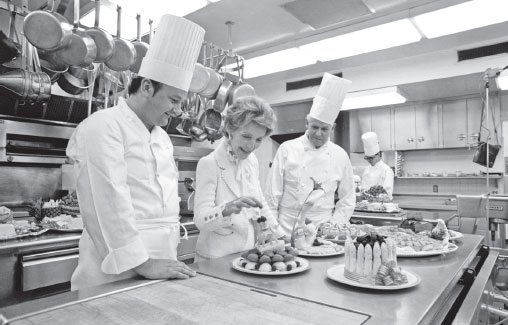
First Lady Nancy Reagan in the White House kitchen. Monkey bread was served at the White House during Christmas events. Courtesy of Ronald Reagan Presidential Library.
Nancy Reagan’s Monkey Bread
6 ounces butter, softened
4½ cups all-purpose flour
1 package active dry yeast
1 cup lukewarm milk
3 large eggs
3 tablespoons sugar
1 teaspoon salt
4 ounces melted butter
Butter and flour a nine-inch mold or bundt pan and set aside. Whisk the yeast with the milk in a large bowl. Whisk in two of the eggs, then add dry ingredients of sugar, salt and four cups of flour. Switch to a spoon when the dough gets stiff. Cut in softened butter and knead the dough in the bowl until it comes together in a ball. Turn out onto lightly floured work area, continuing to knead to keep dough from getting sticky by adding the remaining ½ cup of flour. Place dough in a clean bowl and cover with plastic wrap. Let rise in a warm place for 1 to 1½ hours, until doubled in size.
Return dough to a lightly floured work area and punch it down. Roll dough into a log shape and cut into twenty-eight equal-size pieces. Roll each piece into a ball, dip in melted butter and place in prepared pan, staggering pieces in two layers. Cover loosely with plastic wrap and let rise in a warm place until doubled, about 30 minutes. Preheat oven to 375 degrees. Beat remaining egg and lightly brush the top layer. Bake until top is nicely browned, 25 to 30 minutes. Cool on a rack before sliding out the loaf for serving. For variations, coat the balls in cinnamon and brown sugar. Once baked and cooled, drizzle with cream cheese or jam glaze.
Great Harvest of Acadiana
854A Kaliste Saloom Road
Lafayette
Operating a family-owned bakery in Lafayette in its eleventh year, owners J.P. and his wife, Michelle MacFadyen, incorporate baking both sweet and savory masterpieces every morning. To prepare their version of monkey bread, which J.P. knew as pull-apart bread in his native Pennsylvania, they use surplus cinnamon rolls. The bread is baked and served in a pie pan. Once baked, the round loaf is flipped over and embellished with a special topping of smooth golden honey, pecans and cinnamon sugar.
After spending time in Colorado, the MacFadyens returned to Michelle’s native Louisiana. They began the business of grinding wheat and baking bread made from scratch by opening Great Harvest. Restocking bounty on the shelves, brewing coffee all day, offering samples—these are duties the MacFadyen children have been assigned at the shop since an early age, including setting out tasty treats every Saturday at the local farmers’ market.
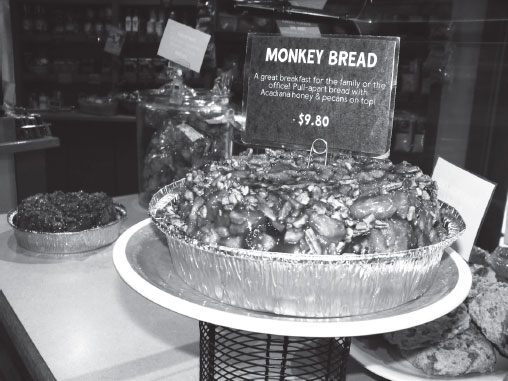
The jumbled-up sweet known as monkey bread. Photo by author.
The specialty bakery is committed to being involved in the community. For Father’s Day, the owners host a hands-on baking session for kids to prepare special cookies for their dads. Getting into the spirit during carnival season, gold, purple and green sugars are sprinkled over their king cake. During a recent flood, the bakery prepared hundreds of trays of treats to serve at local shelters for those displaced from home.
A variety of sandwiches is available for lunch featuring Great Harvest’s hot cross buns, Irish soda bread, sundried tomato bread and walnut fig bread. The oven works nonstop, cranking up before sunrise, slowly turning like a Ferris wheel as rotating trays accommodate a wide variety of breads at a count of three hundred loaves at a time. Their bestsellers are cinnamon burst extreme bread and pepperoni bread. For sweets, they bake muffins, s’mores bars with toasted marshmallows, scones, bread pudding squares, cinnamon rolls as big as the moon, white chocolate berry swirl bread and pumpkin bread. Their version of a holiday fruitcake, called Kentucky Bourbon Bread, includes bourbon-soaked figs, apricots and raisins. The dried fruit is mixed with Louisiana pecans and walnuts and 100 percent whole wheat flour. The bakery’s mission is to incorporate ingredients like honey and produce such as strawberries and figs from local growers and suppliers. There’s lots of down-to-earth originality in making their delicious range of specialty bakery treats.